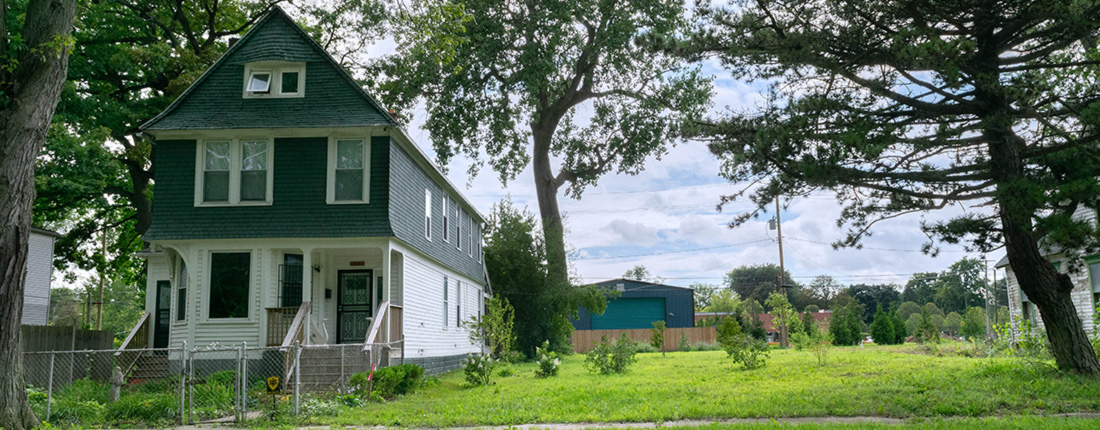Celebrating 20 Years of Land Banks in Michigan
August 17, 2023

In 2023, Michigan land banks mark two important milestones: 20 years since the passage of Michigan’s Land Bank Fast Track Act and incorporation of the 50th land bank in the state. Here’s what community revitalization leaders can learn from Michigan, what impact Michigan land banks have had on neighbors and neighborhoods, and what land bank leaders in the Great Lakes state need to continue their success.
First, what is a land bank?
Land banks are public entities solely focused on putting vacant, abandoned, and deteriorated properties back to productive use according to community goals. A land bank’s primary purpose is to acquire properties that some call “blighted” and temporarily hold and take care of them until they can be transferred to new, responsible owners. Land banks in Michigan are a flexible tool with unique powers granted to them in state law to return vacant properties to productive use as new homes, businesses, or greenspace through demolition, rehabilitation, and maintenance. The Detroit Land Bank Authority (DLBA) is the nation’s largest land bank, with over 75,000 properties in its inventory as of 2022.
Why are there so many land banks in Michigan?
Like in many Midwest and Northeast states, throughout the 20th century cities in Michigan experienced many equity challenges (like segregation, white flight, and poverty) and economic triggers (deindustrialization and the Great Recession of 2008) that contributed to the significant scale of vacant, abandoned, and deteriorated properties across the state.

Michigan’s first land bank was founded in 2002 as the Genesee County Land Reutilization Council (now the Genesee County Land Bank) by Dan Kildee, who later went on to be one of the cofounders and first president of the Center for Community Progress.
In 2003—with the expert guidance of another future Community Progress co-founder, Frank S. Alexander—Michigan passed the Land Bank Fast Track Act (Public Act 258), which ushered in a new generation of land banks that possessed a dramatically different range of powers to land banks that had come before, including, uniquely, a state-level land bank. One facet of the legislation stipulated that Michigan land banks must be created by intergovernmental collaboration between a county and the state land bank.
In the 20 years since this legislation, Michigan has formed 48 county land banks, one city land bank (DLBA), and the state land bank, which serves the remaining 35 counties. The Michigan Association of Land Banks (MALB) helps bring land banks across the state together to share resources and expertise and advocate for state-level policy change. For example, in 2022 the Michigan State House and Senate passed a critical appropriation of over $75 million to a program supporting “blight elimination” across the state—the result of a joint effort between Community Progress and MALB—and later expanded that program by another $75 million.
Positive impacts of land banks in Michigan
All across the country, land banks have documented positive benefits for the communities they serve. Here are a few examples of how land banks in Michigan have helped neighbors and neighborhoods:
- The median sale price increased 11.5% and the mortgage rate increased 5.6% per year where the Detroit Land Bank renovated homes through the Rehabbed and Ready program.
- Between 2009-18, the Calhoun and Kalamazoo County land banks created at least 286 full time jobs in construction, lawn care, and property maintenance.
- The Ingham County Land Bank saw a return of $1.82 for each dollar spent and one job created for every $72,891 spent improving properties.
- Saginaw County Land Bank’s removal of 884 vacant and blighted homes helped reduce major crime in Saginaw by 20%.
- Genesee County Land Bank’s Clean & Green program to maintain vacant lots reduced assaults and violent crimes around vacant lots by 40%.
- Of the more than 15,000 homes sold by the Detroit Land Bank since 2014, about 70% were bought by Detroit residents.
What’s next for Michigan land banks?
Turning abandoned properties into assets that benefit residents is expensive. We estimate that it could cost Michigan land banks an estimated $131.5 million for demolition of properties currently in their inventories, $100 million to stabilize salvageable structures, and roughly $14.5 million per year to mow and clean up vacant lots.
“Land banks connect stakeholders to determine needs and leverage funding to address complicated property issues,” said Krista Trout-Edwards, Executive Director of the Calhoun County Land Bank Authority and head of policy for the Michigan Association of Land Banks. “This county-level work affects urban and rural communities alike, so consistent funding is needed for staffing and projects to ensure communities reach goals and to support the necessary redevelopment of sites in stressed markets. With foreclosure and abandonment often affecting marginalized and historically redlined areas, our work should be inclusive and equitable moving forward.”
The largest portion of funding land banks across the country receive comes from their local governments, and that amount does not cover the scope of the problem land banks are expected to address. Land banks have done incredible work in Michigan, but imagine the possibilities for what they would be able to do if they had sufficient, predictable funding? Then, land banks will truly be able to achieve the transformative revitalization their communities deserve.
Land banking is having a positive impact on communities across Michigan by turning vacant spaces into vibrant places, and Community Progress is proud to be a part of the legacy.
Land bank leaders from Michigan and all over the country will join Community Progress in Cleveland, Ohio on October 16-17, 2023 for the first-ever in-person National Land Bank Network Summit. Land bank staff, leaders, board members, and supporters should register by August 31st to take advantage of Early Bird discounts. Join us in this national movement for solutions in community revitalization and reclaiming vacant properties.
Get the latest tools, resources, and educational opportunities to help you end systemic vacancy, delivered to your inbox.
